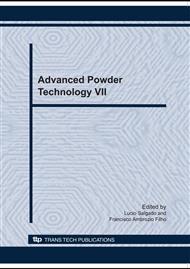p.593
p.599
p.605
p.617
p.623
p.631
p.636
p.641
p.646
Effect of Compacting Pressure on Liquid Phase Sintering of ASTM 2124 Alloy
Abstract:
The use of pressed and sintered aluminum, obtained by the powder metallurgy route, to produce large quantities of near-net-shaped components is increasing rapidly in the automobile industry. The production of lightweight pieces of Al by powder metallurgy has attracted increasing attention due to its unique properties. Sintering helps develop mechanical strength and other properties in commercial alloys obtained by powder metallurgy. Sintering of Al can be achieved only upon formation of a liquid phase capable of destroying the extremely stable oxide layer on the surface of the Al particles. The aim of this investigation was to analyze the effect of compaction pressure on sintering of atomized ASTM 2124 type alloy. Powder characterization was carried out using scanning electron microscopy (SEM). The specimens were axially compacted at pressures of 500, 600 and 700 MPa. Differential scanning calorimetry (DSC) was carried out to determine the sintering temperature of the alloy powder. The specimens were sintered at 570° C. Characterization of the sintered material consisted of density measurements and optical as well as SEM examinations. Nevertheless, even the low recycling cost of Al , what increases its useful time and stabilizes its value, the large amount of energy required to obtain it reduce its application.
Info:
Periodical:
Pages:
623-628
Citation:
Online since:
October 2010
Authors:
Price:
Сopyright:
© 2010 Trans Tech Publications Ltd. All Rights Reserved
Share:
Citation:


